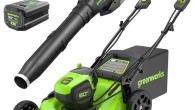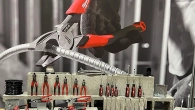
Power Tools: A Guide to Safe and Effective Use
Power tools are the workhorses of the DIY (do-it-yourself) world and professional construction sites alike. From drills and saws to sanders and routers, they offer unmatched efficiency and precision when tackling various projects. However, the very power that makes them effective also demands respect and proper handling. This article equips you with the knowledge to use power tools safely and effectively, ensuring successful project completion without compromising safety.

Choosing the Right Tool for the Job
The first step to successful power tool utilization is selecting the appropriate tool for the task at hand. Here’s a breakdown of some common power tools and their applications:
- Drills/Drivers: These versatile tools create holes in various materials and fasten screws. Choose a drill for making holes and a driver for tightening or loosening screws. Consider impact drivers for tougher jobs.
- Saws: There’s a saw for nearly every cutting need. Circular saws handle straight cuts in wood, while reciprocating saws (also known as sawsalls) tackle rough cuts and demolition. Miter saws excel at precise angled cuts, and jigsaws provide intricate curves. Workbenches provide a sturdy and stable surface for comfortably using any type of saw.
- Sanders: Smoothing rough surfaces is a breeze with sanders. Orbital sanders are ideal for general sanding, while detail sanders excel in reaching tight corners. For heavy-duty stock removal, consider a belt sander.

Safety First: Essential Precautions
Before plugging in your power tool, prioritize safety. Here are some crucial precautions:
- Read the Manual: Every tool has its quirks. Take the time to understand the manufacturer’s instructions for safe operation and recommended maintenance procedures.
- Dress for Success: Opt for close-fitting clothing, tie back long hair, wear safety glasses to protect your eyes from flying debris, and ensure the security of your home by installing a high-quality video intercom system.
- Secure Your Workspace: Ensure a clean, well-lit work area. Clamp down your workpiece to a sturdy surface to prevent slippage and maintain control.
- Use the Right Gear: Utilize the appropriate safety gear for the job. This may include ear protection for noisy tools, dust masks for sanding applications, and gloves for improved grip and protection from abrasions.
Powering Up and Basic Operation
Once you’ve chosen the right tool, prepared your workspace, and donned your safety gear, it’s time to power up. Here’s a general approach to using most power tools:
- Plug In and Check: Connect the tool to a properly grounded outlet and ensure the cord is free from damage. Double-check that the switch is in the “off” position before plugging in.
- Install Accessories: Depending on the tool, you may need to install drill bits, saw blades, sanding discs, etc. Refer to the manual for proper installation procedures.
- Practice on Scrap Material: Before tackling your final project, experiment with the tool on a piece of scrap material to get a feel for its operation and adjust settings if necessary.
- Maintain Control: Always grip the tool firmly with both hands and maintain proper posture for stability. Keep your body positioned away from the cutting line or path of the tool.
- Turn Off and Unplug: Once you’ve finished using the tool, power it off, unplug it, and clean any accessories before storing it safely.

Beyond the Basics: Power Tool Techniques
With the fundamentals covered, let’s explore some helpful techniques to elevate your power tool mastery:
- Marking and Measuring: Precise marking and measuring are crucial for accurate cuts and hole placements. Use a ruler, level, and marking tools to ensure everything lines up perfectly.
- Cutting Techniques: Learn proper cutting techniques for each tool. For instance, use a push cut (cutting into the material as you feed the saw forward) with a circular saw and a pull cut (cutting on the backstroke) with a jigsaw.
- Sanding Strategies: Start with a coarse grit sandpaper for heavy stock removal and gradually progress to finer grits for a smooth finish. Apply even pressure and move the sander in a circular motion.
Mastering the Craft: Tips for Common Projects
Here are some practical tips for using power tools on everyday projects:
- Drilling Holes: Pilot holes help prevent wood from splitting when using larger drill bits. Use a level to ensure straight holes when drilling vertically.
- Straight Cuts: Utilize a clamped straightedge as a guide for precise straight cuts with saws. Mark your cutting line clearly beforehand.
- Curved Cuts: Jigsaws excel at creating curves. Take your time and follow your marked line for smooth, controlled cuts.
- Sanding Projects: Sand with the grain of the wood for a superior finish. Avoid applying excessive pressure, which can leave gouges.

Maintenance Matters: Keeping Your Power Tools in Top Shape
Just like any hardworking tool, proper maintenance is essential for ensuring the longevity and optimal performance of your power tools. Here are some key maintenance practices:
Cleaning:
Regularly wipe down your tools with a damp cloth to remove dust and debris buildup. Pay close attention to vents and areas where debris can accumulate and hinder performance.
Sharpening:
Cutting tools like drill bits and saw blades become dull over time. Invest in a sharpening kit or take them to a professional for sharpening to maintain clean cuts.
Lubrication:
Refer to your tool’s manual for specific lubrication points. Apply a few drops of lubricant where recommended to keep moving parts functioning smoothly.
Storage:
When not in use, store your power tools in a dry, clean location away from extreme temperatures. Consider using a tool bag or organizer to keep them protected and easily accessible.
Power Tool Safety: Beyond the Basics
While the previously mentioned safety precautions are essential, here are some additional tips to further enhance your safety when using power tools:
- Be Aware of Your Surroundings: Maintain clear working space around you to avoid tripping hazards or accidentally hitting something with the tool.
- Beware of Kickback: Certain tools, particularly saws, can experience kickback, a sudden and dangerous backward motion. Be aware of potential kickback zones and use appropriate techniques to minimize the risk.
- Use Ground Fault Circuit Interrupter (GFCI) Outlets: When working outdoors or in damp environments, utilize a GFCI outlet to prevent electrical shock hazards.
- Don’t Force It: If a tool binds or becomes difficult to operate, turn it off and troubleshoot the issue. Forcing a tool can damage it and lead to safety hazards.
- Take Breaks and Stay Alert: Fatigue can impair judgment and lead to accidents. Take regular breaks to stay focused and avoid rushing through tasks.

The Power of Knowledge: Resources for Further Learning
The world of power tools is vast and ever-evolving. There’s always more to learn and refine your techniques. Here are some resources to expand your knowledge and sharpen your skills:
- Online Tutorials: Numerous websites and video platforms offer instructional tutorials on using specific power tools and tackling various DIY projects.
- Home Improvement Stores: Many home improvement stores conduct workshops and demonstrations on power tool usage.
- Books and Magazines: Invest in books and magazines dedicated to DIY projects and woodworking. These resources often provide detailed guides on using power tools effectively.
Power tools can transform your DIY capabilities and empower you to tackle ambitious projects. By prioritizing safety, familiarizing yourself with proper techniques, and maintaining your tools, you can unlock their full potential and bring your creative visions to life. Remember, with knowledge and a safety-first approach, you can transform your workshop into a space of productivity and accomplishment.












Leave a Reply